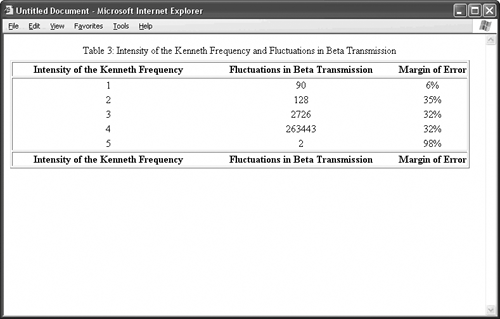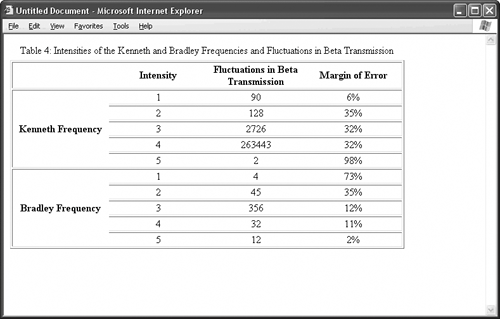| Using the right tags goes a long way toward making your data tables more accessible. You can go even further by adding some finishing touches to your markup.  | FAQDo these accessibility tips work in today's browsers? Not really. File these suggestions in the Forward Compatibility category. The most recent versions of the major browsers don't use this extra markup, and current accessibility tools don't, either. Use these techniques to make your data tables ready for the next generation of Web-browsing technologies. |
|
If the text in your table headers is excessively wordy: <th>Intensity of the Kenneth Frequency</th> <th>Fluctuation in Beta Transmission</th> <th>Margin of Error</th>
you can add your own abbreviations in the abbr attribute of the th tag. Screen readers substitute these abbreviations for the full phrase, which cuts down on the monotony of listening to the data table read aloud. <th abbr="Intensity">Intensity of the Kenneth Frequency</th> <th abbr="Fluctuation">Fluctuation in Beta Transmission</th> <th abbr="Error">Margin of Error</th>
You can also specify exactly which table cells belong under which header cell. To do this, give each th tag in the table header group a unique ID. Then, for each table cell, specify this ID in the headers attribute, like this: [View full width] <table border="1" rules="groups"> <caption>Table 3: Intensity of the Kenneth Frequency and Fluctuations in Beta  Transmission</caption> <col width="300" align="center"> <col width="300" align="center"> <col width="160" align="center"> <thead> <tr> <th abbr="Intensity">Intensity of the Kenneth Frequency</th> <th abbr="Fluctuation">Fluctuations in Beta Transmission</th> <th abbr="Error">Margin of Error</th> </tr> </thead> <!-- This table doesn't have a foot section, which is completely fine. You don't need to Transmission</caption> <col width="300" align="center"> <col width="300" align="center"> <col width="160" align="center"> <thead> <tr> <th abbr="Intensity">Intensity of the Kenneth Frequency</th> <th abbr="Fluctuation">Fluctuations in Beta Transmission</th> <th abbr="Error">Margin of Error</th> </tr> </thead> <!-- This table doesn't have a foot section, which is completely fine. You don't need to  specify every possible group in every table. Just include the ones you need. --> <tbody> <tr> <td headers="intensity">1</td> <td headers="fluctuation">90</td> <td headers="error">6%</td> </tr> <tr> <td headers="intensity">2</td> <td headers="fluctuation">128</td> <td headers="error">35%</td> </tr> <tr> <td headers="intensity">3</td> <td headers="fluctuation">2726</td> <td headers="error">32%</td> </tr> <tr> <td headers="intensity">4</td> <td headers="fluctuation">263443</td> <td headers="error">32%</td> </tr> <tr> <td headers="intensity">5</td> <td headers="fluctuation">2</td> <td headers="error">98%</td> </tr> </tbody> </table> specify every possible group in every table. Just include the ones you need. --> <tbody> <tr> <td headers="intensity">1</td> <td headers="fluctuation">90</td> <td headers="error">6%</td> </tr> <tr> <td headers="intensity">2</td> <td headers="fluctuation">128</td> <td headers="error">35%</td> </tr> <tr> <td headers="intensity">3</td> <td headers="fluctuation">2726</td> <td headers="error">32%</td> </tr> <tr> <td headers="intensity">4</td> <td headers="fluctuation">263443</td> <td headers="error">32%</td> </tr> <tr> <td headers="intensity">5</td> <td headers="fluctuation">2</td> <td headers="error">98%</td> </tr> </tbody> </table>
TIP The IDs of all tags on a page need to be unique. Don't use the same ID for another header tag or any other HTML element on the page. |
For your viewing pleasure, this table appears in Figure 56.10. Figure 56.10. The browser doesn't display a data table any differently when you specify id and headers attributes, but this extra markup will make a difference with the screen readers of the future. 
Another way to improve the accessibility of your data table is to group cells into categories with the axis attribute. Your category names can be anythingjust use the names consistently, as in the following example, where all intensity cells belong to the axis intensities, all fluctuation cells belong to the axis fluctuations, and all error cells belong to the axis errormargins. TIP If the table cell belongs to two or more headers, separate the header IDs with spaces, like this: <td headers="firstheader secondheader thirdheader fourthheader">
|
[View full width] <table border="1" rules="rows"> <caption>Table 4: Intensities of the Kenneth and Bradley Frequencies and Fluctuations in  Beta Transmission</caption> <col width="150"> <colgroup span="3" width="150" align="center"> <thead> <tr> <th> </th> <th abbr="Intensity" axis="intensities">Intensity</th> <th abbr="Fluctuation" axis="fluctuations">Fluctuations in Beta Beta Transmission</caption> <col width="150"> <colgroup span="3" width="150" align="center"> <thead> <tr> <th> </th> <th abbr="Intensity" axis="intensities">Intensity</th> <th abbr="Fluctuation" axis="fluctuations">Fluctuations in Beta  Transmission</th> <th abbr="Error" axis="errormargins">Margin of Error</th> </tr> </thead> <tbody> <tr> <th rowspan="5" abbr="Kenneth">Kenneth Frequency</th> <td headers="intensity kenneth" axis="intensities">1</td> <td headers="fluctuation kenneth" axis="fluctuations">90</td> <td headers="error kenneth" axis="errormargins">6%</td> </tr> <tr> <td headers="intensity kenneth" axis="intensities">2</td> <td headers="fluctuation kenneth" axis="fluctuations">128</td> <td headers="error kenneth" axis="errormargins">35%</td> </tr> <tr> <td headers="intensity kenneth" axis="intensities">3</td> <td headers="fluctuation kenneth" axis="fluctuations">2726</td> <td headers="error kenneth" axis="errormargins">32%</td> </tr> <tr> <td headers="intensity kenneth" axis="intensities">4</td> <td headers="fluctuation kenneth" axis="fluctuations">263443</td> <td headers="error kenneth" axis="errormargins">32%</td> </tr> <tr> <td headers="intensity kenneth" axis="intensities">5</td> <td headers="fluctuation kenneth" axis="fluctuations">2</td> <td headers="error kenneth" axis="errormargins">98%</td> </tr> </tbody> <tbody> <tr> <th rowspan="5" abbr="Bradley">Bradley Frequency</th> <td headers="intensity bradley" axis="intensities">1</td> <td headers="fluctuation bradley" axis="fluctuations">4</td> <td headers="error bradley" axis="errormargins">73%</td> </tr> <tr> <td headers="intensity bradley" axis="intensities">2</td> <td headers="fluctuation bradley" axis="fluctuations">45</td> <td headers="error bradley" axis="errormargins">35%</td> </tr> <tr> <td headers="intensity bradley" axis="intensities">3</td> <td headers="fluctuation bradley" axis="fluctuations">356</td> <td headers="error bradley" axis="errormargins">12%</td> </tr> <tr> <td headers="intensity bradley" axis="intensities">4</td> <td headers="fluctuation bradley" axis="fluctuations">32</td> <td headers="error bradley" axis="errormargins">11%</td> </tr> <tr> <td headers="intensity bradley" axis="intensities">5</td> <td headers="fluctuation bradley" axis="fluctuations">12</td> <td headers="error bradley" axis="errormargins">2%</td> </tr> </tbody> </table> Transmission</th> <th abbr="Error" axis="errormargins">Margin of Error</th> </tr> </thead> <tbody> <tr> <th rowspan="5" abbr="Kenneth">Kenneth Frequency</th> <td headers="intensity kenneth" axis="intensities">1</td> <td headers="fluctuation kenneth" axis="fluctuations">90</td> <td headers="error kenneth" axis="errormargins">6%</td> </tr> <tr> <td headers="intensity kenneth" axis="intensities">2</td> <td headers="fluctuation kenneth" axis="fluctuations">128</td> <td headers="error kenneth" axis="errormargins">35%</td> </tr> <tr> <td headers="intensity kenneth" axis="intensities">3</td> <td headers="fluctuation kenneth" axis="fluctuations">2726</td> <td headers="error kenneth" axis="errormargins">32%</td> </tr> <tr> <td headers="intensity kenneth" axis="intensities">4</td> <td headers="fluctuation kenneth" axis="fluctuations">263443</td> <td headers="error kenneth" axis="errormargins">32%</td> </tr> <tr> <td headers="intensity kenneth" axis="intensities">5</td> <td headers="fluctuation kenneth" axis="fluctuations">2</td> <td headers="error kenneth" axis="errormargins">98%</td> </tr> </tbody> <tbody> <tr> <th rowspan="5" abbr="Bradley">Bradley Frequency</th> <td headers="intensity bradley" axis="intensities">1</td> <td headers="fluctuation bradley" axis="fluctuations">4</td> <td headers="error bradley" axis="errormargins">73%</td> </tr> <tr> <td headers="intensity bradley" axis="intensities">2</td> <td headers="fluctuation bradley" axis="fluctuations">45</td> <td headers="error bradley" axis="errormargins">35%</td> </tr> <tr> <td headers="intensity bradley" axis="intensities">3</td> <td headers="fluctuation bradley" axis="fluctuations">356</td> <td headers="error bradley" axis="errormargins">12%</td> </tr> <tr> <td headers="intensity bradley" axis="intensities">4</td> <td headers="fluctuation bradley" axis="fluctuations">32</td> <td headers="error bradley" axis="errormargins">11%</td> </tr> <tr> <td headers="intensity bradley" axis="intensities">5</td> <td headers="fluctuation bradley" axis="fluctuations">12</td> <td headers="error bradley" axis="errormargins">2%</td> </tr> </tbody> </table>
This table appears in Figure 56.11. Figure 56.11. Grouping cells into axis categories doesn't affect the appearance of the data table in the browser, but the screen readers of the future will use the axis names to better understand the layout of your table. 
| 
